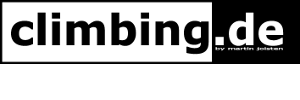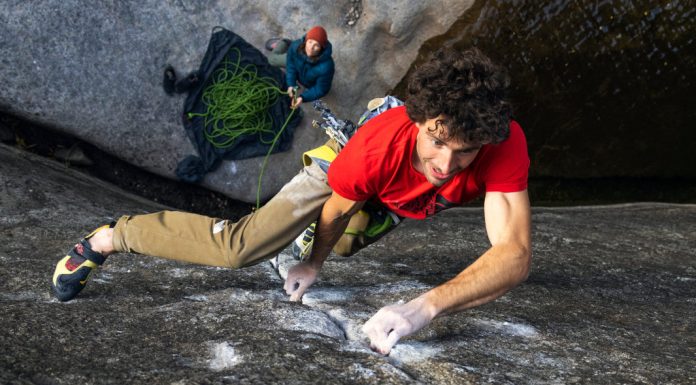DMM Text The romantic landscape of steeply wooded valleys with airily perched castles, known as “Franconian Switzerland', is Germany's best-known climbing area and a world-class sport climbing destination.
It's the birth-place of the redpoint and home to the world's first F8c and F9a; Wallstreet (1987) and Action directe (1991) respectively. The trees often mean the immaculate limestone crags aren't always obvious to find whereas there are some roadside crags such as Bärenschluchtwände and Richard Wagner Fels you simply can't miss.
DMM's Ben Slack, said: “I hope this video inspires a visit from people who haven't previously considered climbing in the Frankenjura as well as being entertaining.”
Here's five things Felix Fromm thinks first-time visitors should know about the Frankenjura:
1. Coffee and cake is a big part of the Franken climbing scene. The kind of cake depends on what fruit is in season.
2. Be careful of ticks in the forest, especially in the spring and summer. They can carry some unpleasant diseases.
3. On Saturday's and Sunday's go to a local pub/brewery such as Bruckmayers in Pottenstein and drink a Heldbraü. [The region has the highest brewery density in the world]
4. Single pitch routes and Power endurance climbing is the usual Frankenjura climbing style, say with 15 hard moves in a row. Expect a lot of pockets.
5. Some classic routes I recommend include Schaumschläger (6a), Rosa Zeiten (6b), Fight Gravity (7a+), Sautanz (7b+), Killer (8b) and Syphon (8b).
PLUS five things Alex Schweikart thinks first-time visitors should know about the Frankenjura:
1. Two good places for climbers to stay in central Frankenjura: the campground Eichler (Untertrubach) run by Martha and the Fischer campsite in Stierberg, close to Betzenstein. [Note: Fischer has vegetarian meals on the menu]
2. There are about 12000 routes spread across 1000 crags with various guidebooks, definitive and selected, with some in English.
3. March to early October is a good time to visit. It can be rainy in the winter with the crags staying wet. While it's trickier to climb hard in the summer it's always possible to find crags in the shade.
4. Respect the environment and any access restrictions. Development of some areas is forbidden and a zone system marked by plaques is used to indicate what is allowed.
5. Some crags and routes I'd recommend: Röthelfels – the 30 metre Zinnober (6-) and Zinnenwand (5-), Reichelsmühler Wand for 7's, Puttlacher Wand for 8's, Obere Gossweinsteiner Wände if 9 is your grade and Holzgauer Wand for good quality routes that are a bit harder.
Getting There: Driving is a good option since you'll need a car for getting to the crags when you are there. If you choose to fly, then Munich Airport is closest and less than two hours drive away, while Frankfurt Airport is only an extra half-hour.
Equipment: Most of the routes in the Frankenjura are well-bolted, although a few of the older and generally easier routes, will feel more amenable if you carry a few nuts and slings. For many of the modern overhanging test-pieces a 50 metre rope should suffice but a 60 or 70 metre rope can be necessary on some of the classic long wall routes.
Other Info: There's a mini-market shop in Obertrubach for groceries and the Leistner Pension Café has great cake and wireless. Café Backerei Müller, up the road towards the church, is another highly recommended “cake venue' and Wolfgang Gullich's final resting place is in the church graveyard behind it.
You'll find supermarkets in Pottenstein and Graefenberg. In Betzenstein there's a fantastic heated outdoor swimming complex and for the hardier there's an unheated outdoor pool in Egloffstein. The Betzenstein pool was the venue for a dws comp [Vid] last May.
UIAA grades are used in the Frankenjura but increasingly you'll hear the lingua franca of French grades at the crag and in the pub [grade comparison table]. There's plenty of topos and more info at climb.frankenjura.com. The book, Fight Gravity, by the late pioneering Frankenjura climber, Kurt Albert, takes an in-depth look at the region's history and is surperbly illustrated, although you'll need to be able to read German to get the most from it.


![[VIDEO] Alexander Megos: URSUS | The days after the send URSUS | The days after the send (c) Alexander Megos](https://www.climbing.de/wp-content/uploads/2024/03/youtube_WCZVR9-tZTc-218x150.jpg)

![[VIDEO] Stefano Ghisolfi: ALL my secrets about ENDURANCE Stefano Ghisolfi: ALL my secrets about ENDURANCE (c) Stefano Ghisolfi](https://www.climbing.de/wp-content/uploads/2024/03/youtube_xlQ2OreHL60-218x150.jpg)
![[VIDEO] THE FULL JOURNEY 9B FA by Alexander Megos THE FULL JOURNEY 9B FA by Alexander Megos (c) Alexander Megos](https://www.climbing.de/wp-content/uploads/2022/12/youtube_QwjykRehg7M-218x150.jpg)
![[VIDEO] MEGATRON V17 MEGATRON V17 (c) mellow](https://www.climbing.de/wp-content/uploads/2022/12/youtube_f_MniTA8MYU-218x150.jpg)
![[VIDEO] Moulin Rouge (7b) Free Solo | Jonas Hainz Moulin Rouge - Free Solo (c) Jonas Hainz](https://www.climbing.de/wp-content/uploads/2022/10/youtube_UQs4KNRBHss-218x150.jpg)
![[VIDEO] Greenpointing and Trad in the Frankenjura](https://www.climbing.de/wp-content/uploads/2014/12/vimeo_45444770-150x150.jpg)
![[VIDEO] Mélissa Le Nevé in "Wallstreet" (8c)](https://www.climbing.de/wp-content/uploads/2014/12/youtube_KzBqlOHrekU-150x150.jpg)
![[VIDEO] Jan Hojer in "Action Directe" (9a)](https://www.climbing.de/wp-content/uploads/2014/12/youtube_qOSRfDktwrY-150x150.jpg)
![[VIDEO] Frankenjura Boulder Mix 1 von André Behr](https://www.climbing.de/wp-content/uploads/2014/12/vimeo_66506892-150x150.jpg)








